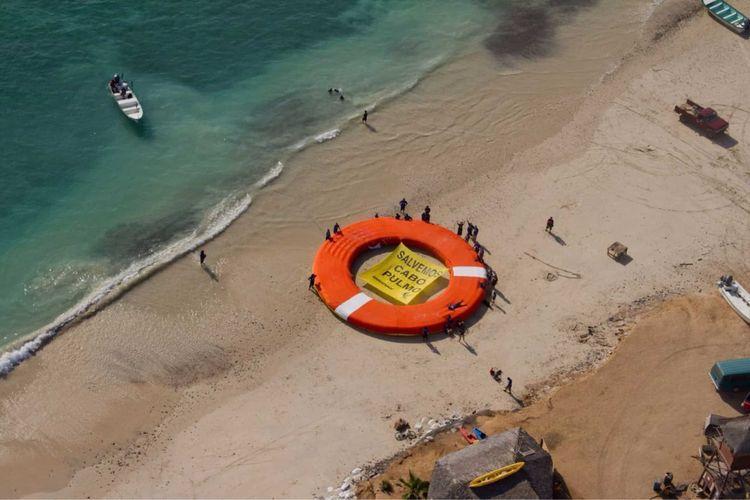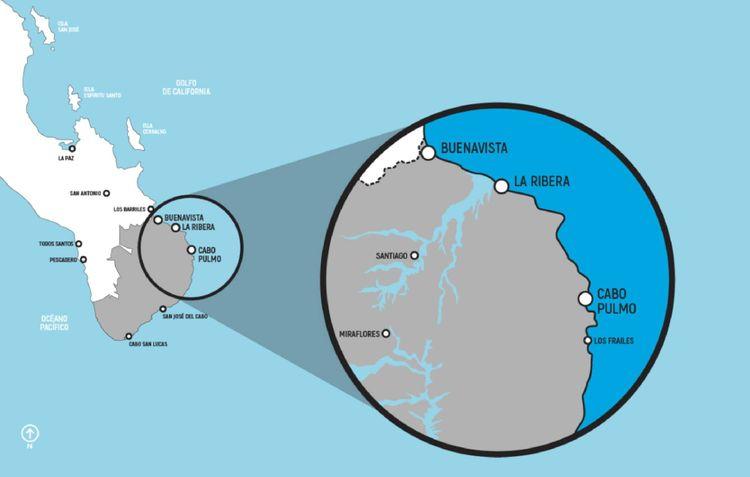Cabo Pulmo is a fishing town that stopped fishing in the 80s, when overfishing threatened to kill its marine area off the coast of Baja California Sur. The decision was the first step in becoming a Protected Natural Area (ANP) in 1995 and a World Natural Heritage Site in 2005.
Today, Cabo Pulmo is known as “the jewel in the crown of conservation” and “the world's aquarium”. Its waters are home to around 800 species that make up the Sea of Cortez. Its recovery has allowed the return of migratory fauna such as whale sharks, humpback whales and sea turtles.
But despite the achievements, Cabo Pulmo has been stalking its back for more than 20 years with the threat.
“Three megaprojects have already been stopped. What (the companies) are doing now is to request supposedly smaller authorizations, but together they form the same thing: the immensity of projects that are not in line with the vision of continuing to preserve the place,” said Judith Castro, president of the Committee for Citizen Participation of the Cabo Pulmo Community.
Judith is the daughter of one of the original families. His father and brothers were among the fishermen who, advised by the Autonomous University of Baja California Sur, made the decision to give up fishing to save “their garden”, as they refer to the coral reefs off the coast of Cabo Pulmo, the largest and oldest in the Gulf of California.
When they left fishing, they became service providers within the ANP. Alongside organizations and residents, they defend the conservation of the area.
The most recent threat is the arrival of apparently small business projects, but on the whole they are not far from megaprojects. An ant invasion, as documented by the newspaper Excelsior.
According to Friends for Conservation of Cabo Pulmo A.C., 18 projects are known to be under development, an average of 30 kilometers away from Cabo Pulmo National Park.

Demonstration to request that the Cabo Pulmo National Park not be destroyed with the construction of the Cabo Cortés tourism project (2011). Source: GREENPEACE/CUARTOSCURO.COM
The monster of 30 thousand rooms and Costa Palma
It started in 2008. The Spanish real estate company Hansa Urbana announced Cabo Cortés, a mega-tourism project that aimed to build hotels and houses totaling more than 30,000 rooms, three golf courses and an airport. The investment would be made a few meters north of Cabo Pulmo.
“At that time, we understood that a common front had to be formed to defend Cabo Pulmo. Include the community, organizations, scientists... To have all the trenches we could need for that defense covered,” Judith Castro recalled of the birth of the Cabo Pulmo Vivo Coalition in 2009, where she represents the community sector.
It was until 2012 that the federal government announced the decision to permanently cancel the Cabo Cortés project. However, in 2014 and 2016, other companies continued with megaproject proposals.
The Cabo Dorado project in 2014 proposed the construction of an ecotourism city. The proposal came from the company China State Construction Engineering Corporation and was summarized in more than 22,000 rooms distributed in nine hotels, 6,000 homes and 4,000 facilities for commerce, restaurants and other services.
After that second rejection, in April 2016, the company BCS Desarrollos Los Cabos, S.A. de C.V. submitted to the Secretariat of Environment and Natural Resources (Semarnat) an Environmental Impact Statement (MIA) for the Cabo Pelícanos project, just 10 kilometers from the Cabo Pulmo National Park. Although in August of that same year, the process was suspended.
“And projects are still coming out, they're not that big, but they have cumulative effects,” said Tania De La Vega, executive director of Friends for Conservation of Cabo Pulmo A.C., another of the organizations participating in the coalition.
In an interview with Causa Natura, Tania De La Vega and Reina Macklis -who is the Regional Liaison Coordinator of the civil association- talk about the ant invasion, taking as an example Costa Palma in La Ribera, Baja California Sur.
The site is located less than an hour from Cabo Pulmo. The main internet searches link Costa Palma to the Canadian hotel chain Four Seasons. One of its establishments is located there, there are also golf courses, housing and other needs of a tourist project.
“Costa Palma is the example of the ant invasion. Each project within that complex is presented individually, when we know that the integration of all represents a greater impact. An impact that will affect the coastline, including the Cabo Pulmo National Park,” said Reina Macklis. Now these megaprojects are built piecemeal.
Macklis and De La Vega talk about the impacts for the area if you don't stop. For example, accelerated growth in the face of a lack of infrastructure that lacks water, drainage and electricity.
“We're not saying that we're against development, we don't want it to remain untouched because that's not the point. We want things to be done right. If there's no water, electricity, security, conservation, you can't come,” said the director.

Location of Cabo Pulmo and La Ribera (where Costa Palma is located). Source: Cabo Pulmo Vivo Coalition
The Search for Political Will
Reina Macklis remembers a Sunday, just a few weekends ago. It tells how a group of people in front of the facilities of the National Commission for Protected Natural Areas (Conanp) stayed on the coast while roasting fish in a non-permitted area. Nothing happened.
“There is a lack of political will. Because there are public policies that could put a stronger lock on authorizing this type of project. However, there are no necessary actions,” said Judith Castro.
For this publication, the Conanp authorities were contacted but no response was obtained.
ANPs are regulated by the General Law on Ecological Balance and Environmental Protection (LGEEPA). As part of the general provisions, it lists that its administration must comply with conservation, good use, exploitation, inspection and surveillance.
“(In the ANP) hydrocarbon activities are prohibited, it's in the law, of course. But megaprojects for tourism are very specific to the decree and its regulations,” said Alejandro Olivera, representative in Mexico of the Center for Biological Diversity.
Judith Castro, like Reina Macklis and Tania De La Vega, agree that there is an urgent need to update the Ecological Management Program.
Semarnat defines it as “an instrument of environmental policy that is conceived as a planning process whose objective is to find a pattern of land occupation that maximizes consensus and minimizes conflict between different social sectors and authorities in a region”.
In other words, it is that there is a prior study process to evaluate the occupation of a territory. Especially if it's an ANP like Cabo Pulmo. The problem is that there have been outdated systems for more than 20 years, according to Friends for Conservation of Cabo Pulmo A.C.
“The other situation is that governments (city council level) are there every three years. And every three years a different story becomes: a new governor comes with a different work plan and there is no follow-up to what was worked on before,” said the Regional Liaison Coordinator.
It also counts as “they don't even have an information file” for advocacy actions such as the Pride Campaign, which has been working on since 2006. In addition to the failures that are repeated in various fishing areas of Mexico, such as inspection and surveillance problems, lack of budget and environmental education.
For the population of Cabo Pulmo, betting on the conservation of the ecosystem is betting on benefits for its members. Decisions are needed to achieve this, beyond our own interests, Castro points out, “but it seems that only those of us standing, those of us who are here, do it.”



Comentarios (0)